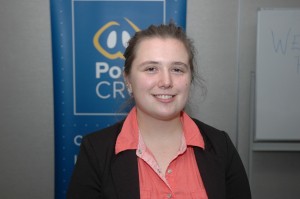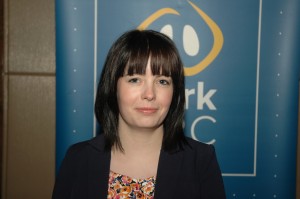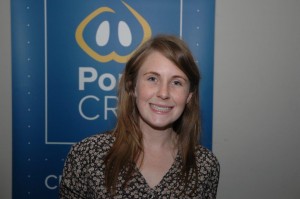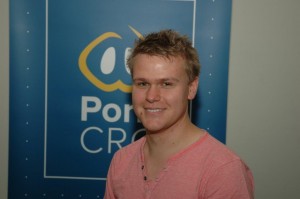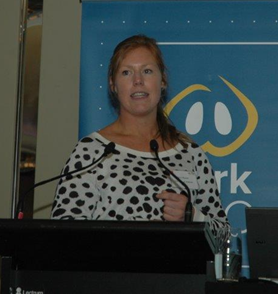Julia Sophia Huser
‘Split suckling of piglets to improve colostrum intake and survival’
Julia Sophia Huser: Pork CRC Honours, University of Adelaide
Supervisors: Wayne Pitchford, Kate Plush, David Lines
Improving piglet welfare
Julia Sophia Huser graduated from University of Adelaide with Honours in 2014.
During her honours year she was supported by Pork CRC’s Program 1, which investigates confinement free sow and piglet management. Her project aimed to improve piglet welfare, more specifically by reducing mortality of smaller sized piglets within the first 24 hours after birth.
Since completing her honours, Julia Sophia has worked at SunPork Farms (previously known as CHM Alliance and APFG), where she began in late February 2015 as an Animal Research Technical Officer. She now assists her former Honours Supervisor, Dr David Lines (Science, Technology and Adoption Manager) on external sow based research in South Australia in collaboration with SARDI and The University of Adelaide.
She is also involved in many internal trials within the group’s commercial herds. Julia Sophia is extremely grateful for the support she received from the Pork CRC, The University of Adelaide and SunPork Farms throughout her honours year, all of which helped kick-start her career in the Australian pork industry.
CRC honours
Julia Sophia’s honours project, which was conducted on a commercial farm (SunPork Farms), investigated the benefits of split suckling neonatal piglets within 24 hours of birth. Conventional split suckling is a maternity ward management technique that reduces teat competition within litters (typically of litters with >11 piglets born alive) and is accomplished by separating the largest, first born piglets from the sow for approximately 2-3 hours, allowing the smaller, later born piglets to access the udder, thereby increasing their chance of colostrum ingestion. Colostrum is rich in antibodies and growth factors and is energy dense, making it essential for piglet survival, as piglets are born immunocompromised and with a lack of energy reserves. Julia Sophia’s Pork CRC honours project investigated how no split suckling (control) and two different types of split suckling – conventional and rotational split suckling, where half the piglets are rotated hourly, allowing all piglets to access the udder without competition for two suckling events – impacted litter mortality and performance.
Suckling stats
The survival of small piglets (<0.85 kg) from the conventional split suckling group was 13% greater than the small piglets in the rotational and control treatment groups. However, the split suckling method had no effect on colostrum ingestion (IgG proportion measured by immunocrit from day one serum samples). Small piglets in the conventional split suckling treatment had improved vigour from day zero to day one, which was different by half a score (0-3 scale), compared to the control or rotational treatment group. This result indicates that split suckling improves the survival of small piglets within large litters through enhancing vigour of these piglets. It was also found that aside from piglet birth weight, body temperature at day zero had the greatest overall effect on the survival of piglets before weaning.
Further information: Julia Sophia Huser, email sophia@austporkfarms.com.au
First printed in APN July 2015 issue
Patricia Condous
PhD Topic – The impact of reducing sow confinement during farrowing and lactation on sow and piglet welfare, behaviour and performance
Pork CRC PhD candidate, University of Adelaide
Supervisors: Dr William van Wettere, Dr Kate Plush and Prof Alan Tilbrook
Satisfying Sows and Saving Piglets
Patricia Condous is in the third year of her Pork CRC supported PhD at the University of Adelaide, School of Animal and Veterinary Science.
Her PhD, as part of Program 1, Reduced confinement of sows and piglets, is investigating the impact of reduced confinement during farrowing and lactation on sow and piglet welfare, behaviour and performance.
Before her PhD, Patricia completed a Bachelor of Science (Animal Science) at the University of Adelaide and then an honours degree, investigating the effect of feed restriction, before and after mating, on embryo survival in gilts.
The farrowing crate is currently the most common form of housing for sows during farrowing and lactation. However, there is increasing concern about the welfare implications for the sow, as the restrictive environment of the farrowing crate prevents the sow from performing nesting behaviours before farrowing and reduces socialisation opportunities with piglets.
Confinement free
Confinement free housing systems have the potential to improve sow welfare and are therefore being investigated as an alternative to farrowing crates. However, a reduction in sow confinement is commonly associated with an increase in piglet mortality, primarily due to crushing by the sow. This represents a significant productivity and welfare problem and hence is one of the main concerns involving the commercial adoption of these systems.
It is understood that the majority of pre-weaning piglet mortality occurs within the first few days post-partum. Hence, a short period of sow confinement during this critical time may be effective at reducing pre-weaning piglet mortality, while still improving sow welfare.
However, there is limited research on the optimal time period to confine the sow so that pre-weaning piglet mortality is reduced. This led to the first trial of Patricia’s PhD, which looked at the effect of confinement versus non-confinement during parturition and different periods of confinement during early lactation on pre-weaning piglet mortality and sow and piglet behaviour. In this study sows were housed in a standard farrowing crate or a swing-sided pen.
Swinging time
Sows housed in the swing-sided pen had the pen open or closed during parturition and opened on day three or seven post-partum. When open, the swing-sided pen allows the sow enough space to turn around and when closed it confines the sow, similar to that of a farrowing crate. The study demonstrated that removing sow confinement during parturition and reducing confinement on day three post-partum increased piglet mortality, mostly due to an increase in crushing. From day eight post-partum until weaning there was no difference in piglet mortality between sows housed in a farrowing crates and sows housed in open swing-sided pens.
Nesting behaviour
When considering sow behaviour, sows that performed more nesting behaviour before farrowing showed increased interactions with piglets during farrowing, while sows that performed more stereotypic behaviour before farrowing were more restless during farrowing. Additionally, while there was no effect of confinement, during early lactation, on sow behaviour, removing confinement after day eight of lactation tended to increase the frequency of nursing events compared to a farrowing crate, but this did not result in improved piglet growth. Overall, the results demonstrated that confinement during the first week of lactation was essential to achieve acceptable pre-weaning piglet survival rates and that reducing sow confinement during the nesting period and during later lactation may improve some aspects of sow welfare and maternal behaviour.
Results of the first study left the question of how to allow the sow space to nest build, but still confine the sow during parturition. Generally, sows begin to nest build 24 to 12 hours before farrowing and then gradually become more inactive and recumbent in the few hours pre-farrowing. Therefore, ideally, we want to loose house the sow during the nesting period and then confine her in the hours pre-farrowing. However, this is not easily possible in naturally farrowing sows as it is difficult to determine the exact farrowing date and often sows will farrow overnight.
Morning confinement
Hence, Patricia’s second and current trial, is investigating whether through farrowing inducement the sow can be loose housed pre-farrowing to allow nesting behaviour and then confined on the morning of the known farrowing date. The main purpose of this experiment is to determine whether farrowing inducement alters nesting behaviour and how this confinement protocol will affect sow behaviour and piglet survival.
Contact Patricia Condous, email patricia.condous@student.adelaide.edu.au
First printed in APN Mar 2015 issue
Emma Greenwood
Optimising the management of group housed gestating sows’
Emma Greenwood: Pork CRC PhD student in Project 1C-103, University of Adelaide.
Supervisors: Prof Paul Hughes, Dr Kate Plush, Dr William van Wettere
Pork CRC PhD helps minimise mixing mayhem
PhD student Emma Greenwood, supported by Pork CRC, completes her PhD in May 2016.
Her PhD has focussed on optimising the mixing of sows into new groups, a project that has been running at the University of Adelaide’s School of Animal and Veterinary Science, as part of Pork CRC Project 1C-103 in Pork CRC Program 1 ‘Reduced confinement of sows and piglets’. The objectives of the larger CRC project are to reduce, and ultimately eliminate, the need for sow confinement during lactation and gestation by developing innovative housing, breeding and suckling systems.
At the time of her last APN student feature in late 2014, Emma was in the midst of the second of three experiments, focusing on examining the effect of novel environments on sow aggression when mixed into new groups. The experiment compared measures of aggression and stress from sows in barren environments, to that of sows housed with rubber mats (creating visual barriers), ropes and brightly coloured (yellow) swinging disks, all suspended from the roof. This experiment had some interesting results. Although there were very few effects on aggression, the time that the sows spent using the enrichment increased over the 20 day experiment. Play behaviour was also evident in the enriched pen, while absent in the standard pen.
Positive behaviours
It is now believed that positive behavioural responses are just as important as negative responses when assessing animal welfare. Therefore, the results suggest that the design of the enrichment itself was very successful, since sows usually tire of enrichment materials fairly quickly, but, in this study, the use of enrichment actually increased as time went on. Another positive finding was that the presence of enrichment didn’t increase aggression, rather the enrichment was valued and used, with the materials not becoming a limiting resource to be fought over. Emma believes enrichment is an area that needs further research, not least to confirm that enrichment doesn’t increase aggression when provided. She also believes that research into reusable and sturdy materials is important, to reduce loss/replacement cycles and attempt to make enrichment of animals economically viable for producers.
Mixing time
Emma’s third and final project has focussed on the timing of sow mixing and what effect this has on sow aggression when they enter into new groups and form hierarchies. The effect of stress on reproduction and productivity depends on the timing of the stress in relation to the stage of the cycle a sow is in at the time of mixing. It may be relevant to manipulate management of grouping, so that important hormonal processes are not adversely affected by increase stress hormone release. Commercial use of group housing for lactating sows is limited, but the recent transition to group housing from stalls has resulted in increased investigation of this housing method and the possibility of alternative mixing times. Mixing in lactation may decrease aggression near important reproductive milestones, but additionally, due to the effects of lactation on the sow, may involve mixing a mellower animal, less susceptible to stress. This study was designed to identify the optimal time to mix sows, with the aim of minimising aggression and stress during the formation of hierarchies and reducing the effects of mixing on sensitive reproductive milestones. Interestingly, if sows are mixed into a multisuckle system on day 21 of lactation, with a group of six sows and their piglets, the aggression is substantially lower than if the sows are mixed at weaning, after artificial insemination or if sows are separated from their piglets and mixed for six hours daily in lactation. The multisuckle treatment also resulted in 2-3 extra piglets per total born litter, compared to all other options.
Parallel project
Emma, along with Dr Will van Wettere, supervised an honours project which ran in parallel with her own, part of Jonathon Van Dissel’s Pork CRC-funded honours. This demonstrated no increased piglet mortality, coupled with decreased stress response and growth check at weaning, in the multisuckle piglets. The experiment was not able to adequately separate the more commonly-used techniques (mixing into groups at weaning or mixing from stalls after insemination), to make a recommendation on these. However, Emma states that the experiment supports the use of multisuckle housing as an effective way of decreasing aggression at the point of mixing, while optimising sow reproduction. Further, she believes it also represents an interesting housing method which needs further investigation.
Emma has been offered post-doctoral placements overseas after her PhD, but is hesitant to leave the Australian industry. She sincerely thanks all those who welcomed her into the industry and guided, supported and encouraged her during her fruitful studies. In particular she thanks Pork CRC, APL, University of Adelaide, SARDI and those producers who have welcomed her onto their properties.
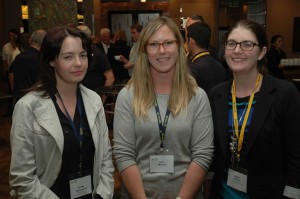 At APSA 2015 in Melbourne, Emma Greeenwood caught up with Alice Weaver of Myora Farm, South Australia and Cassie Dickson, Pork CRC Honours student at University of Adelaide.
At APSA 2015 in Melbourne, Emma Greeenwood caught up with Alice Weaver of Myora Farm, South Australia and Cassie Dickson, Pork CRC Honours student at University of Adelaide.
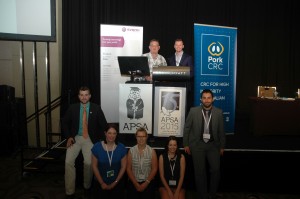 After presenting her paper in the Sow Reproductive Performance session at APSA 2015, Pork CRC PhD candidate Emma Greenwood (seated bottom right) was pictured with her co-presenters and session chair.
After presenting her paper in the Sow Reproductive Performance session at APSA 2015, Pork CRC PhD candidate Emma Greenwood (seated bottom right) was pictured with her co-presenters and session chair.
Contact Emma Greenwood, email emma.greenwood@adelaide.edu.au or emmacgreenwood@outlook.com (once she is finished her PhD)
First printed in APN Apr 2016 issue
Megan Verdon
PhD Topic: Sow aggression in groups: predicting and implications for sow welfare
Pork CRC PhD candidate, University of Melbourne
Supervisors: Prof Paul Hemsworth, Animal Welfare Science Centre and Dr Rebecca Morrison, Rivalea Australia
Verdon verdict on sow aggression
After a brief stint as an industrial chemist Megan Verdon returned to University of Melbourne to complete a Post Graduate Diploma in Animal Science with the Animal Welfare Science Centre. Following this, she commenced her Pork CRC/APL funded PhD, supervised by Prof Paul Hemsworth and Dr Rebecca Morrison, examining the relationship between individual variations in sow aggression and sow welfare. Specifically, she was interested in the identification and protection of vulnerable sows in group-house systems. Megan has now been studying sow aggression for almost five years and earlier this year submitted her thesis on this topic.
This year she was awarded the Department of Agriculture, Fisheries and Forestry (DAFF) 2014 Science and Innovation Award, supported by APL. The funded project examined the effects of pre-weaning socialisation on aggression and injuries when young pigs are mixed post-weaning.
Sow welfare
Confinement housing of gestating sows is subject to increasing community concern and has led to legislative, consumer and retailer pressure to increase the use of group-housing of gestating sows. International industry experience, however, indicates that the opportunity for group housing to improve sow welfare may be limited by high levels of aggression that are commonly observed when unfamiliar sows are mixed, or if sows are required to compete for resources such as space and food.
High and prolonged levels of aggression may negatively affect sow welfare and reproduction by increasing the occurrence of injury and stress. Consequently, reducing aggression between commercial group-housed sows has become one of the main challenges facing animal welfare scientists and pork producers alike.
Individual sow
While group housing of sows allows all more freedom of movement, exploration and socialisation, a few sows may suffer from excessive aggression, injuries and stress. These few animals that have the most severely compromised welfare and reproduction, may remain undetected in groups.
If sows at risk of under-performing, in terms of reproduction, removal and welfare, can be identified, there may be opportunity to develop strategies that better protect such vulnerable sows.
There is limited evidence in young pigs that group composition, in terms of aggressiveness, affects overall welfare and performance of the group. For instance, a particularly aggressive sow may have a disproportionally large effect on the welfare and behaviour of other sows in the group. However, we’re yet to understand the effects of group composition on aggression and welfare in the sow.
CRC project
The first study of this Pork CRC project categorised sows, in both their first and second parities, as submissive, subdominant and dominant, based on their aggressive behaviour and examined the relationships between sow classification, aggression and welfare.
It was found that individual sows vary consistently in their aggressive characteristics, both during and between gestations. Further, the aggression delivered by dominant sows and the aggression received by all sows, reduced with multiple feed drops.
Once a hierarchy is established after mixing, dominant sows had a reduced risk of receiving aggression, and hence reduced injuries. They were also more likely to gain greater weight and experience less stress. While subdominant and submissive sows were comparable in terms of aggression received, live weight gain and reproduction, subdominant females were more likely to experience greater stress, but submissive females had more injuries later in gestation.
These results suggest that variation exists between individual group housed sow in terms of their aggression and consequently welfare and productivity. Submissive sows are likely to benefit from increased access to resources such as space, food and water.
Megan next examined predictive tests of individual sow aggression in mixed parity groups, using the best of test to manipulate group composition, forming groups of sows predicted to be high or mixed aggression. However, there were no effects of group composition on aggression delivered or received, injuries, cortisol concentrations, reproductive performance, or non-reproductive removals in the group as a whole.
The lack of effect of group composition on the behaviour, welfare or productivity of the group suggests older, more experienced sows are more aware of their own fighting abilities and effective in assessing the fighting ability of others. Consequently, the aggressive behaviour of sows is flexible, changing with social experience and group composition. This particularly emphasises the role of social experience in the development and regulation of aggression in the sow.
Community concern
Although community concern is currently focused on confinement systems, with the corresponding move towards group-housing sows community concerns regarding high levels of aggression may become prominent. It is important for the pork industry to remain pro-active in addressing such developing community concerns.
This research highlights to the industry the importance of recognising the individual when considering sow welfare and management, particularly if the welfare of the most vulnerable sows is going to be protected. Such implications for the individual may also apply to other industry welfare issues e.g. transportation and slaughter, fear of humans and stockman-ship and resilience following painful husbandry procedures (e.g. tail docking).
These results also raise an important question – can the welfare of the most vulnerable sows practically be improved through an increased provision of resources (i.e. food, straw, space, barriers, kennel areas etc.)? In such cases, some ‘threshold’ may need to be reached at which extra provisions stop being monopolised by dominant sows and are increasingly available to subordinate sows.
Understanding the development of sow aggression is imperative to reducing aggression, injuries and stress. Socially experienced sows will assess the likelihood of winning an aggressive interaction based on their own genetic predisposition, the physical and aggressive characteristics of their competitor, and their success in prior aggressive encounters. Interactions with older sows throughout adolescence may be integral to the development of social skills in sows, but theremay be less potential for group manipulation to be used as a strategy to reduce aggression and improve sow welfare.
Contact: Megan Verdon, email meganjverdon@gmail.com
First published APN July 2014
Diana Turpin
 PhD Topic: Gradual weaning of piglets: effects on performance and gut health
PhD Topic: Gradual weaning of piglets: effects on performance and gut health
School of Veterinary and Life Sciences, Murdoch University, WA
Supervisor: Professor John Pluske
Gutsy effort for the sake of piglets
Program One (Reduced confinement of sows and piglets) Pork CRC funded student Diana Turpin has just finished the first year of her PhD. Based at the School of Veterinary and Life Sciences at Murdoch University, WA, Diana has a Bachelor of Science and a Bachelor of Veterinary Medicine with Merit Honours. She spent four years working in a small animal veterinary clinic in Perth before returning to Murdoch University to embark on her Pork CRC PhD.
Her research, within Pork CRC Subprogram 1B Innovative weaning systems, focuses on the use of gradual weaning regimes to improve piglet performance, gastrointestinal function and welfare in the pre-weaning and immediate post-weaning period.
Weaning meaning
Piglet welfare and suboptimal production is an ongoing challenge for the pork industry in Australia. Weaning under current commercial conditions generally takes place when piglets are three to four weeks, which is in stark contrast to a weaning age of 12 to 16 weeks under semi-natural conditions and it is characterised by an abrupt transition to independency, involving sudden environmental, dietary and social changes. Since this takes place at an age when piglets are not fully competent to deal with these sudden changes, they pass through an adaptation period, as evidenced by altered behaviour patterns, reduced solid feed intake, a growth check and marked changes to the gastrointestinal tract, increasing pigs’ susceptibility to gastrointestinal diseases.
Intermittent suckling
Intermittent suckling is a type of gradual weaning regime in which the sow and piglets are separated for a specified period of time before weaning. Intermittent suckling has the potential benefit of improving adaption to weaning by mimicking the increasing amount of time sows would spend away from the piglets during the lactation period when sows themselves can control contact with their litter. In doing this, piglets potentially become more familiar with maternal separation and more familiar with solid food as an alternative nutrient source to milk. This could potentially lead to an improved voluntary solid feed intake in the immediate post-weaning period, therefore eliminating the growth check and reducing the risk of disease.
CRC project
While previous studies looking at the effect of intermittent suckling regimes on piglet performance before and after weaning have generally shown positive results for growth, feed intake, gastrointestinal changes and behaviour, most have only measured one or two of these indices at a time and have varied in their length and duration of separation, age of weaning and the age at which separation started. These differences have made it difficult to draw firm and unifying conclusions regarding the effectiveness of this regime with respect to these indices. Diana’s project aims to comprehensively look at the effect intermittent suckling regimes have on piglet performance, gastrointestinal structure and function and behaviour and welfare at the same time, using one type of intermittent suckling regime. The duration of the intermittent suckling regime and length of separation has been selected for its realistic application into an Australian commercial setting (eight hours separation per day during the last week of lactation).
Industry benefits
Weaning is one of the most stressful events a pig will encounter and it is well known that stress plays a critical role in disease susceptibility. If decreasing adaptation time to weaning through a commercially viable intermittent suckling regime could ameliorate such stress, it could alleviate the major constraint that the weaning event has on the pork industry. This project will hopefully demonstrate how using a gradual weaning regime such as intermittent suckling can decrease adaption time to weaning therefore achieving a better post-weaning piglet performance, reducing the risk of weaning associated disease and potentially even reducing the use of antibiotics at weaning.
As well as improving piglet welfare, another possible benefit of intermittent suckling regimes is the potential to induce an oestrus and ovulation during lactation as a result of a reduced suckling stimulus and this may play a role in new production systems.
Contact Diana Turpin, email D.Turpin@murdoch.edu.au
First published APN March 2014
Anthony Martyniuk
Pork CRC Masters project: Optimising the management of group housed sows
Supervisors: Dr Will van Wettere, University of Adelaide, Professor Paul Hughes, SARDI
Anthony Martyniuk is in his second year of a master of philosophy degree through the University of Adelaide and the title of his Pork CRC project is Optimising the management of group housed sows, which is within Pork CRC’s Subprogram 1C, Management of Sows in Groups.
According to Anthony, consumer awareness of welfare for livestock has increased in recent years and this is encouraging the pork industry to evaluate the management of their animals, with further pressure being applied by major supermarket chains announcing that they will only buy product from those farms implementing minimal confinement gestation housing.
It has been agreed by the pork industry that confinement, particularly during gestation, is a major issue and, therefore, following legislative bans in the EU, a voluntary ban on sow stalls in Australia has been announced for 2017.
Pressure on
There is also some pressure being exerted on the use of conventional farrowing crates, hence considerable investment in R&D in Australia into alternative farrowing systems.
Sows were originally moved into confinement to permit better management through reduced aggression during gestation and reduced piglet mortality.
Today, a better understanding of minimal confinement housing systems might enhance sow and piglet welfare, perhaps without loss of production.
However, it is believed that by moving to minimal confinement housing systems, production will decrease, particularly during lactation, when piglet mortality is likely to increase.
Anthony’s project aims to reduce or eliminate time spent by sows in confinement during lactation, to increase sow welfare and also to maintain high production by reducing piglet mortality. To achieve this, he aims to reduce the time spent in confinement during lactation, using a number of different housing systems, which have been designed to replace conventional farrowing crates.
Successful systems
Based on the success of these systems, he will then investigate the link between gestation housing and lactation housing systems to determine if it is a combination of these which contributes to the production value of sows. By the end of his project he hopes to offer a better understanding of minimal confinement housing systems and under what circumstances those systems can function to increase welfare for sows, with no loss of production, compared to conventional farrowing crates.
Anthony completed his Pork CRC honours project in 2011, which investigated using fibre in the diet of gestating sows to reduce aggression, particularly during the first week post insemination when mixed, as this was when implantation occurred and it was a vital time in producing maximum number of piglets per litter.
Feeding high fibre diets markedly reduced aggression in group housed sows and litter size was the same as for sows housed in gestation crates during gestation.
Minimal confinement
This led to his masters project, which is investigating minimal confinement and conventional farrowing and lactation systems.
According to Anthony, it might be a combination of gestation housing and lactation housing which ensures survival of piglets, by minimising stress and increasing the natural maternal behaviour of the sow.
Anthony, who doesn’t have a rural background, did his undergraduate studies in Animal Science at The University of Adelaide.
He said studying Professor Paul Hughes’ subject ‘Pig Production’ is what sparked his interest in the pig industry, which he now believes has “the best opportunities for research”.
Contact details: Anthony Martyniuk, email Anthony.martyniuk@adelaide.edu.au
First printed in APN Oct 2013
Alice Weaver
Pork CRC PhD project: Effect of suckled litter size on oestrus expression, oocyte quality and embryo survival in multiparous lactating sows.
1A-104: Maximising fertility and fecundity of sows mated during lactation, aims to reduce and ultimately eliminate the need for sow confinement during farrowing, lactation and gestation through the development of innovative housing, breeding and suckling systems.
University of Adelaide supervisors: Dr William van Wettere, Dr Karen Kind and Assoc Professor Roy Kirkwood.
During lactation, sow ovarian follicle growth and ovulation are usually prevented by suckling. Previous work by fellow University of Adelaide PhD student Robyn Terry demonstrated that boar contact during late lactation results in high incidences of lactation oestrus in sows suckling 3, 5, 7 and 10 piglets. However, sows suckling 10 piglets had a reduced subsequent litter size compared to sows suckling 7 and 5 piglets.
Following on from this, my first study looked at the potential to mate sows earlier in lactation, with the aim of determining how boar contact and lactation length affect the ability of the sow to express oestrus and ovulate during the first 26 days post-partum. The idea is that we may be able to stimulate the resumption of cyclicity to mate at either the first or second oestrus.
Specifically, I used full boar contact commencing on day 7 post-farrowing and two weaning ages (7 or 26 days) to investigate ovarian follicle growth, oestrus and ovulation. I found that boar contact effectively stimulated lactation oestrus, with 80% of sows exhibiting oestrus regardless of weaning age. However, sows weaned on day 7 expressed oestrus significantly earlier than those which had a full length lactation. Of those sows mated in lactation, pregnancy rates were quite low at 62%. Additionally, sows weaned on day 7 had a reduced subsequent litter size. The data from this project supports previous work from our group, which has demonstrated that boar contact is an effective stimulant of lactational oestrus.
My second study, which has recently been completed, was to follow on from Robyn Terry’s work and investigate the possible cause of the reduction in litter size in sows mated in lactation and suckling a larger litter. Specifically, I aim to determine if it is an effect of reduced oocyte quality before mating, or reduced embryo survival post-mating that is responsible.
All sows suckled 11 piglets from day 3 to day 18 and at day 18, sows were either maintained at 11 piglets or split-weaned down to 7 piglets, where the 4 heaviest piglets were removed. Additionally, at oestrus, some sows were reduced to 7 piglets. From day 18 until weaning, sows received 15 minutes of full physical boar contact. At day 21, half the sows were slaughtered at a commercial abattoir and the reproductive tracts were collected. Oocytes were collected and in vitro fertilisation (IVF) was performed to determine their capacity to be fertilised and develop into an embryo.
The remaining sows were mated in lactation and were slaughtered 30 days later to look at ovulation rate, embryo number, weight and size and embryo survival.
Preliminary analysis of the data showed no difference between suckled litter size in the ability of oocytes to form an embryo in vitro. In the sows mated in lactation and slaughtered at day 30 of gestation, there was no difference between treatments in the percentage of sows expressing oestrus (79%) or the number of days from day 18 until oestrus. However, pregnancy rates were lower in sows suckling 11 piglets for the duration of oestrus (60%) compared to those sows suckling 7 piglets (93%). We found no difference in ovulation rate between treatments, however, the number of viable foetuses and embryo survival was higher in sows suckling 7 piglets from day 18 compared to sows suckling 11 piglets and 7 piglets post-oestrus. Results from sows slaughtered at day 30 post-mating suggest that oocyte quality may contribute to the reduction in subsequent litter size, however further sample analysis is needed to support this hypothesis.
Additionally, in January 2013, I travel to Canada to work with Professor George Foxcroft’s group at The University of Alberta. I have collected oocytes, day 6 IVF embryos and day 30 embryos, which will be transported to the Swine Reproduction Centre for analysis, using the porcine Embryogene microarrays and qRT-PCR to analyse key genes. This will be important in further exploring oocyte and embryo quality at a genetic level.
Results from both my trials will be useful in developing a management strategy for mating sows in lactation to increase piglet weaning age and develop confinement free farrowing systems.
Contact details: Alice Weaver, alice.weaver@adelaide.edu.au
First printed in APN Jan 2013 issue




